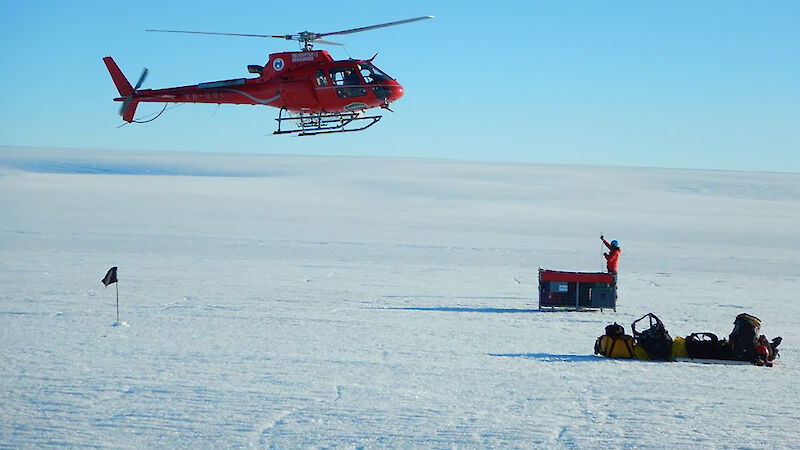It’s expensive in time and money to do research in Antarctica. Research programs can be put at risk because of simple and avoidable equipment failures. We offer the following advice about making and using equipment so that it will always work correctly, and allow you to get maximum utility from it.
Plan for Antarctic conditions
Equipment for Antarctic field work will be exposed to low temperatures, freeze-thaw cycles, melting ice, strong winds, grit blasting and strong static electricity.
Temperatures go from above zero to −40 °C in coastal regions. Inland regions have temperatures which may never go above zero and which may drop to −60 °C. Temperatures may occasionally go below −80 °C in far inland regions.
The wind can blow up to 200 km/h in coastal regions, and it will carry grit in areas where there is no snow cover.
Antarctica has very dry air which results in large amounts of static electricity, particularly when the wind is strong. Static electricity can instantly destroy unprotected electronic equipment.
You might waste the effort invested in your research program if your equipment does not work correctly in these conditions.
Test and verify your equipment
The single most important thing is to test your equipment before taking it to Antarctica. This is obvious, but many people don’t do it and their research programs are compromised by equipment failures which are completely avoidable.
Make sure that your equipment works correctly at the temperatures you will encounter in Antarctica. Also check that the cables remain flexible and the enclosure prevents the ingress of moisture or grit.
Do not rely on the equipment manufacturer’s claims about the operating temperature range for your equipment. Verify the correct operation of your equipment for yourself before you go to Antarctica.
Perform these tests well before you depart for Antarctica. Give yourself plenty of time to fix any deficiencies in your equipment.
Batteries
All types of battery have reduced performance in the cold; they go flat faster and have less ability to deliver electricity in the cold. Make sure you are using batteries suitable for the temperatures you will encounter in Antarctica.
- Always use fresh batteries from the major battery manufacturers. Don’t use cheap batteries because they will cost you dearly with their poor performance.
- Use batteries which are commonly available.
- If using rechargeable batteries, use batteries which are tolerant of the type of charger so you have more options should things go wrong.
- Never use carbon-zinc batteries in Antarctica.
- Alkaline batteries are usable down to −30 °C.
- Lead acid batteries are usable down to −30 °C if they are kept well charged. They are easy to recharge if you don’t know how to recharge batteries. They can be recharged at low temperatures.
- Nickel cadmium batteries are usable down to −30 °C. Don’t use nickel cadmium batteries if they are idle for weeks because they will probably go flat. They might not be rechargeable at low temperatures.
- Lithium batteries have several different types of chemistry and some types are usable to below −40 °C. Make sure that you have the correct type. Note that you must have the correct battery charger to recharge lithium ion batteries; these batteries are fussy.
Electrical cables
The metal wires in cables are unaffected by the cold, but the plastic covering may become rigid and shatter in the cold. Make sure that your cables are flexible and usable at the temperatures you will encounter in Antarctica.
Don’t rely on the cable manufacturer’s claims of temperature performance. You must test the cables in your particular operating conditions.
The most common insulation (covering) on electrical cables is PVC plastic. Be careful about using PVC below −10 °C. Some of the synthetic rubber insulations are usable down to −30 °C. The fluorocarbon insulations (Teflon, tefzel, PVDF, etc) and silicone insulations are usable below −60 °C.
Loose cables and wiring looms can cause equipment failure due to vibration, both in transit and in high wind conditions. Make sure that cables and wiring looms are well secured with cable ties or adhesives, etc.
Construction materials
Many common materials behave differently at Antarctic temperatures and become unsuitable for use in equipment. The obvious change is that pliable and flexible materials become progressively harder and more brittle at lower temperatures. Equipment that is fine in the office or lab becomes stiff or shatters in the cold. The cold also causes equipment seals to fail and allows the ingress of moisture and grit.
Lubricants become thick or solid at Antarctic temperatures thus immobilising equipment.
In general, do not use cheap domestic electronic and mechanical components in equipment. Instead, use the more rugged industrial or commercial grades of components. For example, a lot of equipment is fitted with cigarette lighter style power connectors which are completely unsuitable for Antarctic use. Replace them with XLR style connectors.
Make sure that all the materials in your equipment behave as required at the temperatures you will encounter in Antarctica.
Enclosure sealing
Your equipment must be watertight so it will keep out moisture and grit. Water ingress causes rapid failure of electronic equipment, and sea-water in particular is lethal for electronic equipment. Make sure that the enclosure for your electronic equipment, and the plugs and sockets, is watertight and remains so at Antarctic temperatures.
If your equipment is subjected to cycles of hot and cold, it will pump air and water vapour through any gaps in the sealing. The water vapour will condense to water or ice inside the equipment and damage it.
Mechanical equipment also needs sealing against the ingress of moisture and grit. Moisture will become ice inside the equipment and hinder its operation.
Optical equipment
Any optical lens or window on your equipment may be rendered useless by moisture in the form of condensation, icing or hoar frost.
Lenses and windows may be permanently damaged by wind-borne grit, especially in areas with no snow cover. The grit will change your lenses and windows into frosted glass. Your equipment should have some method to protect lenses and windows from the grit.
Displays
Most measuring equipment has a display on it. The most common displays are LCDs (liquid crystal displays) and LEDs (light emitting diodes). CRT (cathode ray tube) displays are used occasionally.
- Remember that you may have to read your display through a layer of frozen condensation.
- LCDs might not work at all in the cold, or their response will be so slow that they are useless.
- LEDs work fine at low temperatures, but they might be hard to read in the very bright glary sunlight of Antarctica.
- CRTs behave similarly to LEDs.
Ergonomics
Can you operate your equipment in the field in Antarctica? You will be wearing heavy mitts or gloves, so anything with small buttons or knobs or screws or tiny displays may be impossible to operate. Make sure you can operate your equipment easily when you are clothed for severe Antarctic conditions.
Spare parts and repairs
Take a full kit of spare parts, operation and repairs manuals with you to Antarctica. Do not assume that replacement parts for your equipment will be available at the Antarctic stations. If the equipment is critical to the success of your research program, take two units and spare parts so you can replace a faulty unit and repair it while your research program continues.
Design your equipment with standardisation of parts in mind. Use industry standard parts if possible. Using standard parts means you are more likely to get replacement parts at the Antarctic stations or from other equipment.
There are basic repair facilities at the stations for electrical, mechanical and electronic equipment. If your project relies on a PC or similar, make sure you bring backup copies of all software used on the PC, including the operating system.
Electromagnetic interference (EMI) and electromagnetic compatibility (EMC)
Australia’s Antarctic stations have many pieces of equipment that rely for their correct operation on access to the radiofrequency spectrum without risks from interference. This includes telecommunications equipment and scientific equipment.
Electrical and electronic equipment sent to Antarctica must be designed to minimise electromagnetic emissions that could cause harmful interference to such telecommunications and scientific systems. Equipment must also be designed to operate reliably in the presence of strong electromagnetic fields generated by high power telecommunications and scientific transmitters.
Licensing of equipment
All equipment (including scientific equipment) that is designed to emit RF radiation must be licensed by the Australian Communications and Media Authority (ACMA).
Approval for operation of this equipment in Antarctica must also be sought from the Australian Antarctic Division (AAD) Telecommunications Manager before the equipment is sent. Any proposed changes to the operation of the equipment must also be approved by the Telecommunications Manager. If the equipment, once installed, is found to be causing interference to telecommunications equipment or other scientific equipment, the Telecommunications Manager may direct that the equipment be shut down until the problem can be fixed.
Need further assistance?
If you have any questions about building reliable scientific equipment for Antarctic or marine science use, please contact us at:
Polar Technology Manager
+61 3 6232 3361



